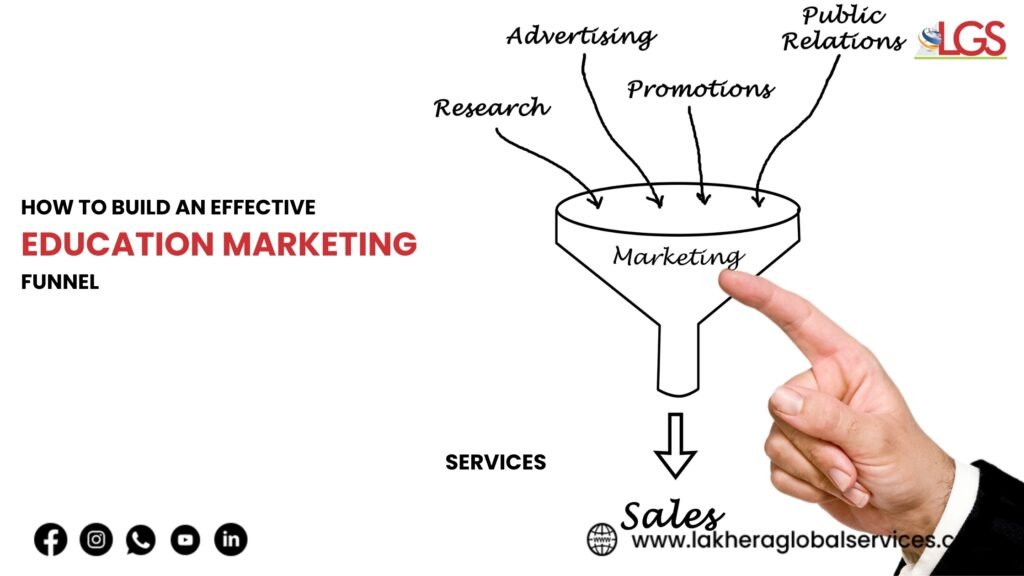Marketing Funnel is the backbone of any successful education marketing strategy. For institutions and educational service providers, building an effective marketing funnel can transform how prospects discover, consider, and eventually enroll in educational programs. In this comprehensive guide, we’ll walk you through every stage of constructing a high-performing marketing funnel designed to maximize enrollment and drive long-term growth.
By the end of this blog, you’ll have a clear roadmap on how to create a tailored marketing funnel that converts prospects into students. Let’s dive in.
1. Introduction: The Power of a Marketing Funnel in Education
1.1. Why a Marketing Funnel is Essential
- Definition: A marketing funnel is a structured pathway that guides potential students from initial awareness through consideration, conversion, and finally retention.
- Purpose: It ensures that every touchpoint with your audience is strategic, relevant, and optimized for conversion.
- Impact: A well-designed funnel not only boosts enrollment but also enhances student satisfaction and long-term engagement.
1.2. The Role of Education in Funnel Marketing
- Tailored Messaging: Education marketing requires a deep understanding of your audience’s needs and pain points.
- Engagement: By segmenting your audience and delivering personalized content, you drive higher engagement at each funnel stage.
- Sustainable Growth: A strategic Marketing Funnel can help educational institutions build a sustainable pipeline of enrolled students.
2. Understanding the Marketing Funnel: What It Is and Why It Matters
2.1. Stages of the Marketing Funnel
- Top of the Funnel (Awareness): Capture the attention of prospective students with broad content and compelling storytelling.
- Middle of the Funnel (Consideration): Educate and nurture your audience with targeted content that addresses their specific needs.
- Bottom of the Funnel (Conversion): Convert leads into enrolled students through personalized offers and clear calls-to-action.
- Retention: Keep your students engaged and encourage referrals through ongoing communication and support.
2.2. Benefits of a Structured Marketing Funnel
- Clarity: A clear funnel structure helps streamline your marketing efforts and align your team’s strategies.
- Efficiency: Focused messaging and targeted campaigns reduce waste and maximize your marketing budget.
- Measurability: With defined stages, it’s easier to measure performance at each step and optimize accordingly.
2.3. The Importance for Educational Institutions
- Niche Targeting: Education marketing requires precision; a well-structured funnel allows you to reach specific segments with tailored content.
- Long-Term Engagement: A robust funnel doesn’t end at conversion—it extends into retention and advocacy, critical for sustainable growth.
3. Creating Awareness: The Top of the Funnel
3.1. Building Brand Recognition
- Content Marketing: Publish informative blog posts, videos, and infographics that introduce your institution and its values.
- Social Media Campaigns: Use platforms like Facebook, Instagram, LinkedIn, and Twitter to reach a broad audience.
- Paid Ads: Leverage Google Ads and social media advertising to boost visibility among targeted demographics.
3.2. Crafting Compelling Messaging
- Storytelling: Develop narratives that resonate with potential students and highlight your unique selling propositions.
- Visual Appeal: Use high-quality graphics, images, and video to capture attention and communicate professionalism.
- Consistent Branding: Ensure that all communications reflect your institution’s tone, mission, and vision.
3.3. Optimizing for SEO
- Keyword Integration: Include relevant keywords (such as “education,” “enrollment,” and “Marketing Funnel”) naturally within your content.
- Meta Descriptions & Titles: Craft engaging meta tags that improve click-through rates and search engine rankings.
- Link Building: Develop a network of internal and external links to boost your domain authority.
4. Driving Consideration: The Middle of the Funnel
4.1. Nurturing Leads with Valuable Content
- Educational Webinars: Host online sessions that provide in-depth insights into courses, career prospects, and learning methodologies.
- Email Newsletters: Deliver targeted content to keep your audience informed about programs, events, and success stories.
- Case Studies: Showcase testimonials and success stories that build trust and highlight tangible benefits.
4.2. Personalizing the Experience
- Segmentation: Divide your audience based on interests, academic background, and engagement level.
- Tailored Messaging: Use personalized email sequences and targeted content to address specific pain points.
- Interactive Tools: Incorporate quizzes, surveys, and self-assessment tools to engage users and gather valuable insights.
4.3. Leveraging Social Proof
- Testimonials: Feature student and alumni testimonials that validate your institution’s impact.
- User-Generated Content: Encourage current students to share their experiences on social media.
- Reviews and Ratings: Display ratings and reviews prominently to enhance credibility.
5. Optimizing Conversion: The Bottom of the Funnel
5.1. Effective Calls-to-Action (CTAs)
- Clear Messaging: Use concise and persuasive CTAs such as “Apply Now” or “Get More Information.”
- Visibility: Place CTAs in high-traffic areas of your website and emails for maximum impact.
- Urgency: Create a sense of urgency by highlighting limited spots or application deadlines.
5.2. Streamlining the Enrollment Process
- User-Friendly Forms: Simplify application forms to reduce friction and improve completion rates.
- Responsive Design: Ensure that all enrollment pages are optimized for both desktop and mobile devices.
- Real-Time Assistance: Implement chatbots or live chat support to address questions and guide prospects through the process.
5.3. Testing and Optimization
- A/B Testing: Experiment with different CTAs, landing page designs, and form layouts to identify the most effective approach.
- Performance Metrics: Track conversion rates, bounce rates, and time on page to continuously refine your strategy.
- Feedback Loops: Use surveys and user feedback to understand barriers to conversion and address them promptly.
6. Retaining and Engaging Your Audience
6.1. Building Long-Term Relationships
- Onboarding Programs: Develop comprehensive onboarding processes that help new students integrate smoothly.
- Continuous Communication: Maintain regular contact through newsletters, social media, and exclusive events.
- Loyalty Programs: Create referral incentives, alumni networks, and other loyalty programs to encourage ongoing engagement.
6.2. Providing Ongoing Support
- Student Portals: Offer access to resources, academic support, and community forums.
- Feedback and Surveys: Regularly gather feedback to improve programs and address student needs.
- Engagement Metrics: Monitor engagement and retention rates to identify opportunities for improvement.
6.3. Fostering Community and Advocacy
- Peer Interaction: Encourage student collaboration and networking through online communities.
- Ambassador Programs: Empower satisfied students to become brand ambassadors, sharing their success stories.
- Event Hosting: Organize webinars, Q&A sessions, and meetups to keep the community active and engaged.
7. Integrating Content Marketing into Your Funnel
7.1. Creating High-Quality Content
- Informative Blogs: Write comprehensive articles that address common questions and challenges in education.
- Video Tutorials: Develop video content that explains complex topics and demonstrates your value proposition.
- Infographics and eBooks: Create visually appealing resources that summarize key information in an easily digestible format.
7.2. Distributing Content Effectively
- Multi-Channel Strategy: Share your content across websites, social media, email, and partner channels.
- Content Calendars: Plan and schedule content regularly to ensure consistency and relevance.
- Guest Posting: Leverage opportunities to contribute to reputable education and industry blogs to expand your reach.
7.3. Measuring Content Performance
- Engagement Metrics: Track likes, shares, comments, and page views to gauge content effectiveness.
- SEO Impact: Monitor keyword rankings and organic traffic as a measure of content success.
- Conversion Tracking: Evaluate how content contributes to moving prospects down the funnel towards enrollment.
8. Leveraging Data and Analytics to Refine Your Marketing Funnel
8.1. Utilizing Analytics Tools
- Google Analytics: Monitor website traffic, user behavior, and conversion paths.
- CRM Systems: Use customer relationship management tools to track leads and communications.
- Heatmaps: Analyze user interactions on your website to identify areas for improvement.
8.2. Data-Driven Decision Making
- Performance Dashboards: Create dashboards to view key metrics at a glance.
- Regular Reporting: Schedule periodic reviews of funnel performance to identify trends and challenges.
- Iterative Improvements: Use data insights to make incremental improvements that enhance overall funnel performance.
8.3. Predictive Analytics and Future Planning
- Trend Forecasting: Leverage historical data to predict future trends and adjust your strategies.
- ROI Measurement: Continuously evaluate the return on investment of your marketing activities.
- Strategy Refinement: Use insights to reallocate budget and resources for maximum impact.
9. Personalization and Segmentation Strategies
9.1. Crafting Customized Experiences
- Dynamic Content: Use personalization engines to display content tailored to individual user profiles.
- Targeted Campaigns: Segment your audience based on behavior, demographics, and interests to deliver bespoke messaging.
- Email Personalization: Craft targeted email sequences that address the specific needs of different segments.
9.2. Advanced Segmentation Techniques
- Behavioral Segmentation: Analyze how users interact with your site and tailor follow-up actions accordingly.
- Demographic Segmentation: Use demographic data to create profiles that guide your content and offers.
- Psychographic Segmentation: Understand the values, attitudes, and motivations of your audience to better connect with them.
9.3. Benefits of Personalization
- Increased Engagement: Personalized experiences lead to higher engagement and conversion rates.
- Enhanced Customer Loyalty: When prospects feel understood, they’re more likely to become long-term supporters.
- Improved ROI: Targeted messaging reduces waste and maximizes the impact of your marketing spend.
10. Future Trends: Innovating Your Marketing Funnel Strategy
10.1. Embracing Emerging Technologies
- Artificial Intelligence: Utilize AI-driven tools for predictive analytics, chatbots, and dynamic content personalization.
- Voice Search Optimization: Optimize your website and content for voice search to capture new audiences.
- Augmented Reality: Explore AR experiences that provide immersive previews of your institution.
10.2. Adapting to Market Changes
- Agile Marketing Strategies: Stay flexible and ready to pivot your approach based on market trends and user feedback.
- Continuous Learning: Keep abreast of new tools, platforms, and best practices in education marketing.
- Long-Term Vision: Focus on building a sustainable funnel that evolves with technology and user expectations.
10.3. Preparing for the Future
- Integrated Marketing: Combine digital, social, and offline strategies to create a comprehensive, future-proof marketing funnel.
- Scalability: Ensure your funnel strategy can grow with your institution’s needs.
- Innovation: Constantly experiment with new ideas to maintain a competitive edge in an ever-changing landscape.
Conclusion: Transform Your Education Marketing Funnel for Long-Term Success
A well-designed Marketing Funnel is critical for the success of any education marketing strategy. By building a structured pathway that takes prospects from initial awareness to final enrollment—and beyond—you create an ecosystem that drives sustainable growth, higher engagement, and increased revenue.
From creating compelling awareness campaigns to nurturing leads through personalized content, every step of your funnel should be optimized for maximum impact. As you refine your strategy with data-driven insights, embrace emerging technologies, and focus on delivering tailored experiences, your institution will stand out in the competitive education landscape.
EdTech Startups and established institutions alike can benefit immensely from a robust Marketing Funnel that not only drives conversions but also builds lasting relationships with students.
Contact Lakhera Global Services Today & Transform Your Enrollment Strategy!
- Supercharge Your Growth: Unlock cutting-edge, data-driven marketing strategies designed for educational institutions.
- Tailored Solutions: Our expert team crafts personalized marketing plans that align with your unique goals.
- Proven Expertise: With years of experience in education marketing, Lakhera Global Services turns prospects into enrolled students.
- Free Consultation: Book your consultation today and discover how our innovative solutions can elevate your Marketing Funnel.
- Your Success, Our Mission: Let’s build a legacy of excellence and innovation—your growth is our top priority.
Take action now—visit Lakhera Global Services and schedule your free consultation. Revolutionize your Marketing Funnel and watch your enrollment numbers soar!
FAQs
What is a Marketing Funnel and why is it important in education marketing?
A Marketing Funnel is a structured pathway that guides prospects from initial awareness to conversion and retention. It is crucial for education marketing because it helps target the right audience, deliver personalized content, and maximize enrollment rates.
How can I improve the top of my marketing funnel?
Focus on creating engaging content, building brand awareness through social media and SEO, and using targeted paid advertising to attract a broad audience.
What strategies can boost conversion rates at the bottom of the funnel?
Optimize your website with clear CTAs, simplify the enrollment process, use A/B testing to refine your approach, and provide real-time support through chatbots or live chat.
How do personalization and segmentation improve my Marketing Funnel?
By tailoring content and messaging to specific audience segments, you create a more relevant and engaging experience, which increases the likelihood of converting prospects into enrolled students.
How can Lakhera Global Services help optimize my Marketing Funnel?
Lakhera Global Services specializes in data-driven, customized marketing strategies that address each stage of your funnel, from awareness to conversion and retention. Their expert team works with educational institutions to design and implement solutions that drive sustainable growth.









